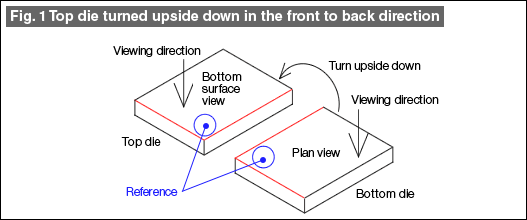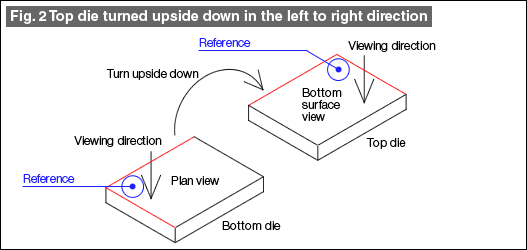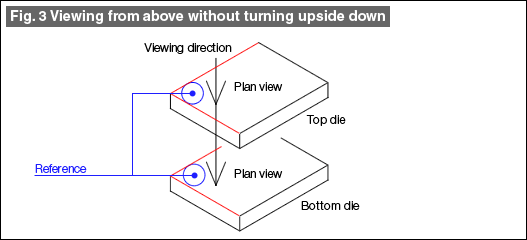#097 Fundamentals of Press Die Structure Design (6) Method of Expressing the Plates of the Top Die and Bottom Die
When expressing dies, the bottom die is expressed in the state in which it is viewed from above. This is the plan view in the drawing methods. The top die is very frequently expressed in the state in which it has been removed from the bottom die, turned upside down, and is viewed from above. This becomes the plan view in drawing methods. There are several methods of expressing the top die.
Fig. 1 is the method of expression when the top die is turned upside down in the front to back direction. This figure has been expressed using the double surface reference method. Although the dimensions do not change along the X-axis, the dimensions along the Y-axis are reversed from front to back. In the case of dies for successive feeding, this state can be said to be easy to understand because it matches with the movement of the material.

Fig. 2 is the method of expression when the top die is turned upside down in the left to right direction. Although the dimensions do not change along the Y-axis, the dimensions along the X-axis are symmetrical in the left - right manner. In the case of dies for successive feeding, it can be said that the relationship between the top die and the bottom die is difficult to understand.

Since the dies are shown in the opened state in the methods of expressing in Fig. 1 and Fig. 2, they are in the same state as an actual die, and can be said to be a view that makes it easy to understand the inside of the dies. However, at the time of machining the plates, there is a difference between the plan view state and the bottom surface view, and care will have to be taken while machining the plates. A method of expressing considering this aspect is the one shown in Fig. 3. This is a method that makes machining of the plates easy. The method of expressing the top die makes it difficult to understand the structure of the dies.

The method of expressing the top die changes because of the differences in the method of expressing the top die. When only the plate drawing has been sent to the machining site, if the machining is done without being aware of this difference, the prepared plates will not be usable. Unify the method of expressing the top die so that there are no mistakes in machining the plates.
- #167 Problems in Punching and their Countermeasures (6) Scrap Processing in Punching
- #166 Problems in Punching and their Countermeasures (5) Trimming of Drawn and Shaped Parts
- #165 Problems in Punching and their Countermeasures (4) Scrap Clogging in Punching
- #164 Problems in Punching and their Countermeasures (3) Bending and Twisting of Narrow Punched Parts
- #163 Problems in Punching and their Countermeasures (2) Bending due to Punching



